Abstract
The aim of this study was to explore the effect of invasive plant species on birds in Wattle Park in Melbourne, Australia. The study would help in understanding the complex interplay between invasive plant species and bird types. Four sites measuring 100 ft x 100 ft were surveyed in Wattle Park for two days to gather data on bird types in the invasive plant species. Data were collected within 15 minutes in every site by observing and identifying bird species on the marked tree and shrub species within the study sites. Data on bird type distribution in the study sites were analyzed using Excel. The results indicated that certain bird types were common in some sites than in other sites. It was concluded that invasive plant species influenced bird species distribution and community composition in the Park.
Introduction
Invasive plants have greater potential to influence the number, population composition, and stability of bird populations by changing resources availability, altering habitat compositions, and transforming food quality or interfering with the entire food chain. As a result, Grice (2006) claims that plant invasions present a serious threat to biodiversity. Plant invasion has affected the conservation and management of species globally. This is clearly the case in Australia in which plant invasion is linked to “habitat clearance, livestock grazing, forestry and soil degradation due to pressure on native species and communities” (Grice 2006, p. 27). On the contrary, Gan, Li, Chen, and Ma (2007) noted that invasive fruiting plants were sometimes beneficial to an ecological setup. Various exotic taxa such as plants, mammals, and birds, among others, had significant effects on ecology. For instance, any exotic species have abilities to influence native bird species in various ways. There are predatory mammals that come with invasive plants. Other bird species and mammals may compete for habitats and foods. Hybridization may occur and lead to a loss of the genetic composition of the native species. Invasive plant species may also cause direct or indirect changes in native habitats and food resources of birds. In addition, there could be loss and fragmentation of native birds’ habitats due to changes in the composition of the species and structures of native plant composition (Gan et al. 2007). Holland-Clift, O’dowd, and Nally (2011) found that willow invasion affected food resource and changed habitat, which in turn reduced native bird biodiversity and disrupted interrelations in the affected riparian zone.
A study by Scheiman, Bollinger, and Johnson (2003) explored whether exotic grass had any effects on the abundance of birds, plants, and arthropods. The researchers established that the number of birds was significantly lower in exotic-grass-dominated areas of the study (Scheiman et al. 2003). In addition, the “density of the ground-foraging bird guild was lower on exotic sites because the seeds and insect resources located on the ground were less abundant on exotic sites” (Scheiman et al. 2003, p. 648). In this particular study, invasive grass species had negative influences on the functional relationship between birds and their habitats, foods, and prey. Invasive grass offered few foods for breeding bird populations. In addition, invasive grass also suppressed native plant species and reduced niches for arthropods (Scheiman et al. 2003). Milton et al. (2007) observed that some invading species of plants had abilities to change the savanna by suppressing native trees. This transformation led to an ecosystem-level effect (Milton et al. 2007). Exotic host trees also had similar effects on the open savanna. There were changes in the diversity, presence, and composition of tree species. Overall, invasive plant species bring about complex interplay in an ecological setup by affecting food distribution and habitats of birds (Milton et al. 2007; Ortega, McKelvey & Six 2006).
Aim of the Study
The aim of this study was to explore the effect of invasive plant species on birds in Wattle Park. In this regard, the study addressed the following issues:
- Whether invasive plant species attracted specific bird species than others
- Whether invasive plant species affected the presence of birds in various study sites in Wattle Park
Study Area
The study was conducted at the Wattle Park in Melbourne, Australia, which is a large area with various indigenous and invasive plant species. The Park is a significant place because of its high diversity of common native and exotic fauna and flora. Plant species range from ground covers and shrubs to big trees that provide habitats and food for various bird species and other mammals. Thus, it is imperative to understand the effect of invasive plant species on the birds in the Park.
Study Methodology
Sites with invasive trees and shrubs in the Park were chosen for the study. These study sites were chosen because they had various plant and bird species. The major birds found in the study sites included magpie, crow, rainbow parrot, and noisy miner among others.
Stratification of study sites
Data were collected on two field trips. Invasive trees and shrub species were sampled to identify various birds they attracted. The investigators collected data from the identified invasive tree and shrub species with the aim of sampling several species.
Invasive vegetation species were classified into tree and shrub species with further classification as trees 1, 2, and 3 and shrub 1, 2, and 3. Study sites were classified as sites 1 and 2 for both shrubs and trees. For every vegetation type, there were two sites. This represented four sites for the study. Samples from these sites were used for data analysis and reporting.
Care was taken not to damage the vegetation species or cause harm to birds.
Data Collection
The investigators used a tape measure to measure 100 ft x 100 ft for every study site. They then used a marker to transect each study site. All four sites were studied within two days. Each site was studied within 15 minutes by counting bird species on various invasive trees and shrubs. Binoculars were used to look at distant birds while a bird’s book was used to identify various birds.
Data recorded included the following:
- Location sites with regard to tree and shrub species
- Bird species
- The number of experiment in each study site
The investigators identified various bird species and named them. However, they failed to identify only a single bird type, which was noted as Species number 1.
Care was taken to ensure that the correct birds were identified in each site and on specific vegetation.
Data Analysis
Data were analyzed using Excel to determine frequencies and percentages.
Study Results and Discussion
All birds observed in all the four study sites were 374. They included magpies, crows, rainbow parrots, Rosella parrots, noisy miners, green parrots, ravens, and unidentified bird types (Species number 1). The most common bird type was the noisy miner, while the least common was the raven (Table 1).
Table 1: All bird types observed across all the study sites
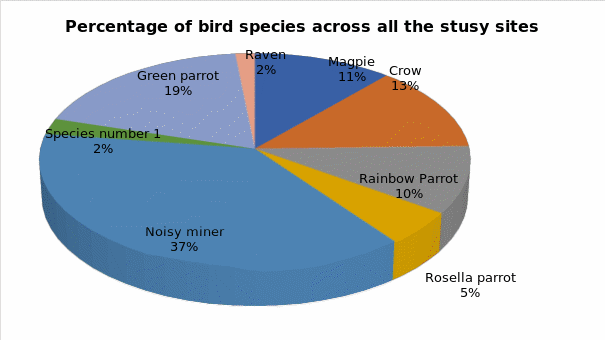
Tree Sites
Site 1 had 113 bird species, while site 2 had 110 bird species.
Shrub Sites
Site 1 had 55 bird types, while Site 2 had 96 birds.
There were 223 bird types observed in the Tree Sites, while Shrub Sites had 151 bird types.
Whether invasive plant species affected the distribution of birds in various study sites in Wattle Park
The invasive plant species affected the distribution of bird communities across various study sites. For instance, the Tree sites had more birds than the Shrub sites (figure 2). In addition, the distribution of bird types also differed significantly within the Tree and Shrub sites (figure 3-5).

Bird communities were highly distributed in some trees than in others.
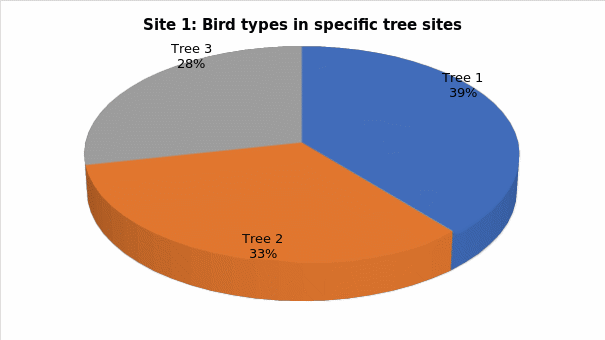
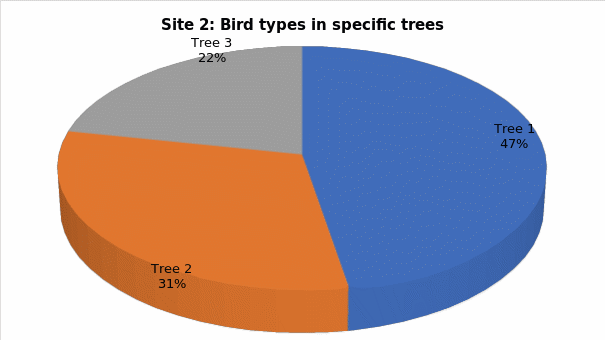
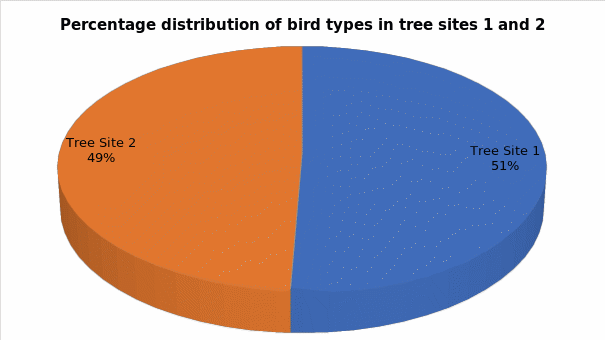
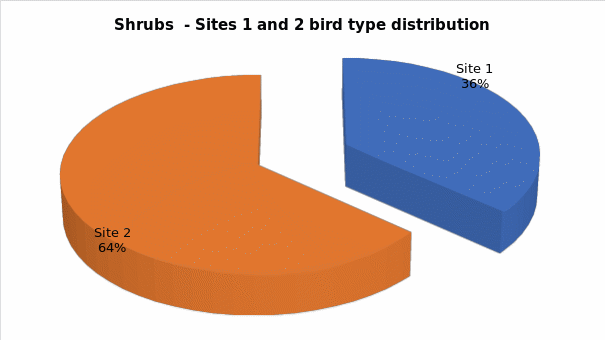
Whether invasive plant species attracted specific bird species than others
The most common bird type observed in the study sites was the noisy miner, while the least observed bird type was the raven (table 1 and figure 1). The noisy miner was common in Site 2 Tree 1 than in other locations. The raven was not observed in the study Tree Site 2.
On the other hand, there were more ravens in Shrub sites than other bird species, while Species number 1 was not present in Shrub Site 2.
These results indicated that specific invasive plant species attracted specific bird species than others. In addition, not all bird species were distributed in all the study sites. The bird type distribution varied from site to site in both Tree and Shrub sites.
Certainly, invasive plant species affected the presence of birds in various study sites in Wattle Park. Invasive plant species affected bird species distribution in different ways. For instance, there were many specific bird species in other parts of the sites than in others. That is, invasive tree sites had many bird species than invasive shrub sites. Past studies have established that invasive plant species affected bird species distribution and population by altering food resources and habitats (Ortega et al. 2006; Holland-Clift et al. 2011). Consequently, there were more bird species in certain sites than other sites. Food resource availability is an imperative factor for any bird species and influences their choices of habitat. Hence, the invasive plant species provided supportive ecosystem for the noisy miner than other bird species.
This study supported previous findings by other researchers that invasive plant species altered the biodiversity, distribution, and species composition of birds in a given area (Lau 2013; Gan et al. 2007; Ortega et al. 2006). In addition, invasive plant species affected many species throughout the entire Park, particularly those species whose survival was highly connected to other affected species. The study results showed the complex interplay between invasive plant species and bird types in Wattle Park.
Reference List
Gan, X, Li, B, Chen, J, & Ma, Z 2007, ‘The ecological effects of biological invasions on birds’, Biodiversity Science, vol. 15, no. 5, pp. 548-557. Web.
Grice, A C 2006, ‘The impacts of invasive plant species on the biodiversity of Australian rangelands’, The Rangeland Journal, vol. 28, pp. 27–35. Web.
Holland-Clift, S, O’dowd, D & Nally, R M 2011, ‘Impacts of an invasive willow (Salix × rubens) on riparian bird assemblages in south-eastern Australia’, Austral Ecology, vol. 36, no. 5, pp. 511–520. Web.
Lau, J A 2013, ‘Trophic consequences of a biological invasion: do plant invasions increase predator abundance?’, Oikos, vol. 122, no. 3, pp. 474–480. Web.
Milton, S, Wilson, J, Richardson, D, Seymour, C, Dean, W & Ipongaş, Ş 2007, ‘Invasive alien plants infiltrate bird-mediated shrub nucleation processes in arid savanna’, Journal of Ecology, vol. 95, no. 4, pp. 648–661. Web.
Ortega, Y, McKelvey, K & Six, D 2006, ‘Invasion of an exotic forb impacts reproductive success and site fidelity of a migratory songbird’, Oecologia, vol. 149, no.2, pp. 340-351.
Scheiman, D, Bollinger, E and Johnson, D 2003, ‘Effects of Leafy Spurge Infestation on Grassland Birds’, The Journal of Wildlife Management, vol. 67, no. 1, pp. 115-121.